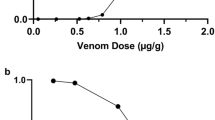Abstract
There is a growing interest in the potential of bee venom in cosmetics as a rejuvenating agent. Products currently on the market do not specify exactly their content of bee venom (BV). Therefore, we developed a method for the detection and quantification of melittin, as a marker of bee venom content, in selected commercial creams which contained BV according to their marketing claims, in order to gauge the relative quality of such formulations. A quantitative method was achieved following a rigorous extraction procedure involving sonication, liquid-liquid extraction and solid phase extraction since carryover of excipients was found to cause a rapid deterioration in the chromatographic performance. The method employed a standard additions approach using, as spiking standard, purified melittin isolated from bee venom and standardised by quantitative NMR. The aqueous extracts of the spiked creams were analysed by reversed phase LCMS on an LTQ Orbitrap mass spectrometer. The purity of the melittin spiking standard was determined to be 96.0 %. The lowest measured mean melittin content in the creams was 3.19 ppm (±1.58 ppm 95 % CI) while the highest was 37.21 ppm (±2.01 ppm 95 % CI). The method showed adequate linearity (R 2 ≥ 0.98) and a recovery of 87.7–102.2 % from a spiked blank cream. An assay precision of <20 % RSD was achieved for all but one sample where the RSD value was 27.5 %. The method was sensitive enough for use in routine assay of BV-containing cosmetic creams. Differences in the melittin content of the commercial products assayed were nearly tenfold.




Similar content being viewed by others
References
Gagliardi L, De Orsi D, Dorato S (2007) General review of official methods of analysis for cosmetics in different countries. In: Salvador A, Chisvert A (eds) Analysis of Cosmetic Products. Elsevier, Amsterdam, pp 45–71
Gao W, Gray N, Heaton J, Smith NW, Jia Y et al (2012) UV gradient combined with principal component analysis: highly sensitive and specific high performance liquid chromatography analysis of cosmetic creams. J Chromatogr A 1228:324–328
Kokot ZJ, Matysiak J (2009) Simultaneous determination of major constituents of honeybee venom by LC-DAD. Chromatographia 69:1401–1405
Terwilliger TC, Eisenberg D (1982) The structure of melittin. I. Structure determination and partial refinement. J Biol Chem 257:6010–6015
Van Vaerenbergh M, Cardoen D, Formesyn EM, Brunain M, Van Driessche G et al (2013) Extending the honey bee venome with the antimicrobial peptide apidaecin and a protein resembling wasp antigen 5. Insect Mol Biol 22:199–210
Chen J, Lariviere WR (2010) The nociceptive and anti-nociceptive effects of bee venom injection and therapy: a double-edged sword. Prog Neurobiol 92:151–183
WHO/IUIS (2014) Allergen Nomenclature. www.allergen.org: Allergen Nomenclature Sub-Committee
Orsolic N (2012) Bee venom in cancer therapy. Cancer Metastasis Rev 31:173–194
Ferreira Junior RS, Sciani JM, Marques-Porto R, Lourenco Junior A, Orsi RO et al (2010) Africanized honey bee (Apis mellifera) venom profiling: seasonal variation of melittin and phospholipase A(2) levels. Toxicon 56:355–362
Alvarez-Rivera G, Lores M, Llompart M, Garcia-Jares C (2013) Cosmetics and toiletries: chromatography. Reference Module in Chemistry, Molecular Sciences and Chemical Engineering: Elsevier, Waltham
Matysiak J, Schmelzer CEH, Neubert RHH, Kokot ZJ (2011) Characterization of honeybee venom by MALDI-TOF and nanoESI-QqTOF mass spectrometry. J Pharm Biomed Anal 54:273–278
Bu X, Chandran S, Spirig J, Wang Q (2011) Sample preparation for selected nonsolid dosage forms. In: Nickerson B, editor. Sample preparation of pharmaceutical dosage forms: challenges and strategies for sample preparation and extraction: American Association of Pharmaceutical Scientists. pp 179–210
CTPA (2013) How are cosmetics regulated? Definition of a cosmetic. CTPA Website: CTPA
Llompart M, Celeiro M, Pablo Lamas J, Sanchez-Prado L, Lores M et al (2013) Analysis of plasticizers and synthetic musks in cosmetic and personal care products by matrix solid-phase dispersion gas chromatography–mass spectrometry. J Chromatogr A 1293:10–19
Tullo C (2013) Consumer protection: the cosmetic products enforcement regulations 2013. In: Kingdom PotU, editor. 20131478. United Kingdom: The Stationery Office Limited. pp 1–28
Denisov E, Damoc E, Lange O, Makarov A (2012) Orbitrap mass spectrometry with resolving powers above 1,000,000. Int J Mass Spectrom 325:80–85
Zhou J, Zhao J, Zhang S, Shen J, Qi Y et al (2010) Quantification of melittin and apamin in bee venom lyophilized powder from Apis mellifera by liquid chromatography-diode array detector-tandem mass spectrometry. Anal Biochem 404:171–178
Evstigneev MP, Parkinson JA, Lantushenko AO, Kostjukov VV, Pahomov VI (2010) Hexamer oligonucleotide topology and assembly under solution phase NMR and theoretical modeling scrutiny. Biopolymers 93:1023–1038
Malz F, Jancke H (2005) Validation of quantitative NMR. J Pharm Biomed Anal 38:813–823
Bruce GR, Gill PS (1999) Estimates of precision in a standard additions analysis. J Chem Educ 76:805
Communities TCotE (2002) Commission Decision 2002/657/EC. In: Union E, editor. L221/8. 17 August 2002: Official Journal of the European Communities
Ellison SL, Thompson M (2008) Standard additions: myth and reality. Analyst 133:992–997
Bishop JE, Kou D, Manius G, Chokshi PH (2011) Sample preparation method validation. In: Nickerson B, editor. Sample preparation of pharmaceutical dosage forms: challenges and strategies for sample preparation and extraction. 1 ed: American Association of Pharmaceutical Scientists. pp. 233–251
ICH (1996) Validation of analytical procedures: methodology, ICH Topic Q2B (CPMP/ICH/281/95). The European Agency for the Evaluation of Medicinal Products
Danzer K, Currie LA (1998) Guidelines for calibration in analytical chemistry—Part 1. Fundamentals and single component calibration (IUPAC recommendations 1998). Pure And Appl Chemistry 70:993–1014
Moldoveanu S, David V (2015) Chapter 7—Solid-phase extraction. In: David SM (ed) Modern sample preparation for chromatography. Elsevier, Amsterdam, pp 191–286
Acknowledgments
We thank the Korean Government KIAT scheme and Wissen Co. for the support for the work.
Author information
Authors and Affiliations
Corresponding author
Rights and permissions
About this article
Cite this article
Tusiimire, J., Wallace, J., Dufton, M. et al. An LCMS method for the assay of melittin in cosmetic formulations containing bee venom. Anal Bioanal Chem 407, 3627–3635 (2015). https://doi.org/10.1007/s00216-015-8578-5
Received:
Revised:
Accepted:
Published:
Issue Date:
DOI: https://doi.org/10.1007/s00216-015-8578-5




